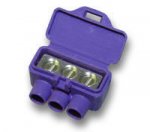jaylectricity
Senior Member
- Location
- Massachusetts
- Occupation
- licensed journeyman electrician
I was always under the impression that you can't tie copper and aluminum together but I'm replacing devices in an old house with almost all copper conductors. But there have been a few places where it was aluminum cable 12AWG.
One switch just had the copper feed on one terminal and the aluminum load on the other terminal. It was a regular switch.
A couple of receptacles had a copper pigtail spliced under a regular red wirenut with an aluminum conductor. The copper terminated on the device.
These have been installed for quite awhile. They were grounded receptacles, but flat-head screws installed on metal boxes. I'm guessing at least 20 years ago.
I do not see a single sign of corrosion, heating or any other sort of damage.
What gives?
One switch just had the copper feed on one terminal and the aluminum load on the other terminal. It was a regular switch.
A couple of receptacles had a copper pigtail spliced under a regular red wirenut with an aluminum conductor. The copper terminated on the device.
These have been installed for quite awhile. They were grounded receptacles, but flat-head screws installed on metal boxes. I'm guessing at least 20 years ago.
I do not see a single sign of corrosion, heating or any other sort of damage.
What gives?


